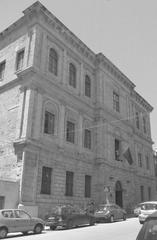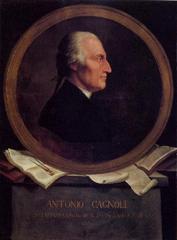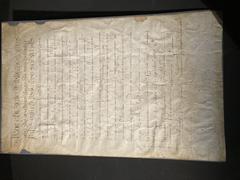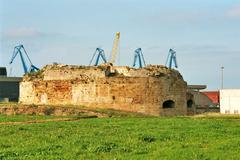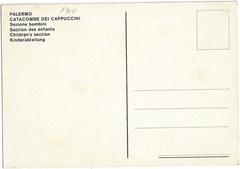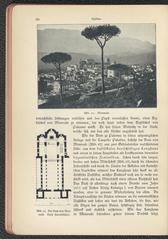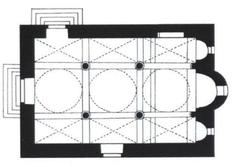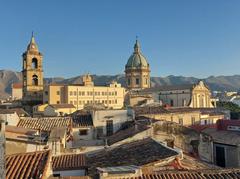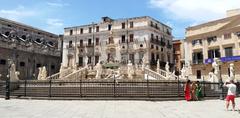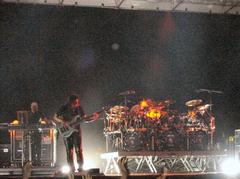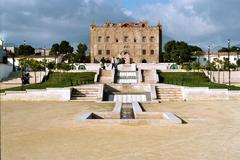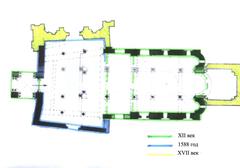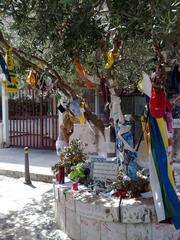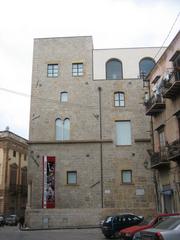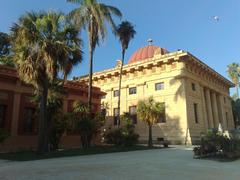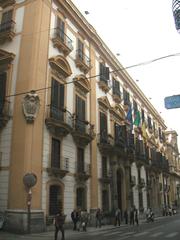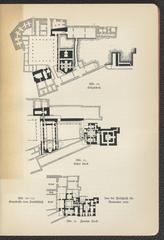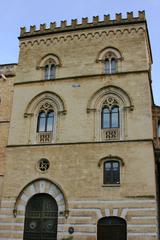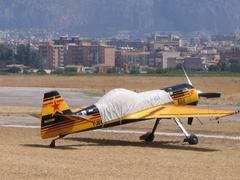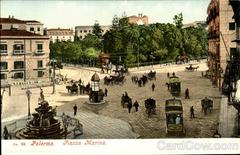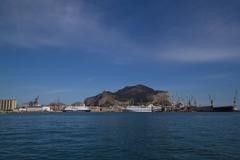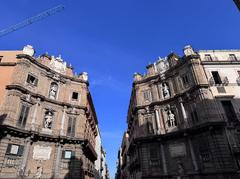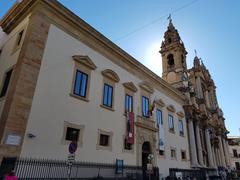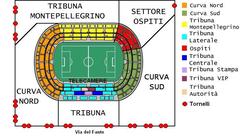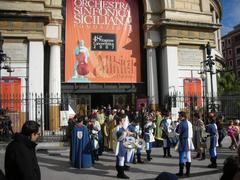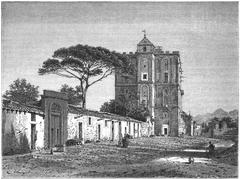Palazzo Chiaramonte-Steri Visiting Hours, Tickets, and Historical Significance
Date: 24/07/2024
Introduction
Palazzo Chiaramonte-Steri in Palermo, Italy, is a remarkable testament to Sicily’s rich and multifaceted history. This medieval palace has witnessed numerous transformations, serving as a noble residence, a site of the Holy Inquisition, and now the rectorate of the University of Palermo. Visitors to this historical gem are introduced to a blend of architectural brilliance, haunting historical artifacts, and a vibrant cultural scene. This guide aims to provide comprehensive information for those planning a visit to Palazzo Chiaramonte-Steri, including essential visitor tips, historical insights, and recommendations for making the most of your trip. Whether you’re drawn by its gothic arches, the chilling history of its torture rooms, or the vibrant contemporary exhibitions, Palazzo Chiaramonte-Steri offers a captivating experience that delves into both the dark and the luminous aspects of Palermo’s past. For more detailed information, you can explore resources like Enjoy Sicilia and Frommer’s.
Essential Visitor Tips for Exploring Palazzo Chiaramonte-Steri in Palermo
Opening Hours and Admission
Palazzo Chiaramonte-Steri is open to the public, but it’s essential to check the latest opening hours before planning your visit. Typically, the palace is open from Tuesday to Sunday, with hours varying slightly depending on the season. Admission fees are generally modest, with discounts available for students, seniors, and groups. For the most accurate and up-to-date information, visit the official Palazzo Chiaramonte-Steri website.
Guided Tours
To fully appreciate the historical and cultural significance of Palazzo Chiaramonte-Steri, consider joining a guided tour. These tours are often available in multiple languages, including English, Italian, and Spanish. Guides provide in-depth insights into the palace’s history, architecture, and the haunting stories of the Inquisition. Booking in advance is recommended, especially during peak tourist seasons.
Accessibility
The palace is committed to being accessible to all visitors. There are ramps and elevators to accommodate those with mobility issues. However, some areas, particularly the older sections of the building, may have limited accessibility. It’s advisable to contact the palace staff ahead of your visit to discuss any specific needs or concerns.
Photography
Photography is generally allowed in most areas of Palazzo Chiaramonte-Steri, but flash photography and tripods are typically prohibited to protect the artworks and the integrity of the historical site. Always check for any specific restrictions upon arrival and respect the guidelines provided by the staff.
Nearby Attractions
Palazzo Chiaramonte-Steri is conveniently located in the Kalsa district of Palermo, making it easy to combine your visit with other nearby attractions. The Giardino Garibaldi, a beautiful public garden, is just across the street and offers a peaceful retreat. Additionally, the Antonio Pasqualino International Puppet Museum and the Santa Maria dello Spasimo are within walking distance.
Dining Options
After exploring the palace, you might want to enjoy some local cuisine. The Kalsa district is home to numerous cafes and restaurants offering traditional Sicilian dishes. For a quick bite, try a local trattoria, or for a more formal dining experience, there are several highly-rated restaurants nearby. Be sure to try local specialties such as arancini, panelle, and cannoli.
Souvenirs and Shopping
While there isn’t a dedicated gift shop within Palazzo Chiaramonte-Steri, the surrounding area offers plenty of opportunities to purchase souvenirs. Local markets and shops sell a variety of items, from handcrafted ceramics to traditional Sicilian puppets. The nearby Vucciria Market is a great place to find unique gifts and experience the vibrant local culture.
Safety and Etiquette
Palazzo Chiaramonte-Steri is a historical site, and visitors are expected to respect the property and its artifacts. Avoid touching the exhibits and stay within designated areas. The palace is generally safe, but as with any tourist destination, it’s wise to keep an eye on your belongings and be aware of your surroundings.
Special Events
Throughout the year, Palazzo Chiaramonte-Steri hosts various cultural events, including art exhibitions, concerts, and lectures. These events offer a unique opportunity to experience the palace in a different light and gain deeper insights into its historical and cultural context. Check the palace’s official events calendar for upcoming events during your visit.
Transportation
Palazzo Chiaramonte-Steri is easily accessible by public transportation. The palace is within walking distance of several bus stops, and a free tourist shuttle also serves the area. If you’re driving, there are parking facilities nearby, but availability can be limited, especially during peak times. Using public transportation or walking is often the most convenient option.
Language
While many of the staff and tour guides speak multiple languages, it’s always helpful to know a few basic Italian phrases. This can enhance your experience and make interactions smoother. Most informational signs within the palace are available in both Italian and English.
Weather Considerations
Palermo enjoys a Mediterranean climate, with hot summers and mild winters. If you’re visiting during the summer months, be prepared for high temperatures and consider visiting the palace during the cooler morning hours. In winter, while temperatures are mild, it’s still a good idea to bring a light jacket.
Contact Information
For any additional questions or specific inquiries, you can contact Palazzo Chiaramonte-Steri directly. The staff is generally very responsive and can provide detailed information to help plan your visit. Contact details are available on the official website.
Visiting Palazzo Chiaramonte-Steri - History, Tickets, and Must-See Highlights in Palermo
Transformation into a University Rectorate
In the modern era, Palazzo Chiaramonte-Steri has undergone significant transformations, adapting to contemporary needs while preserving its historical essence. Today, the building houses the rectorate of the University of Palermo, a prestigious institution that plays a crucial role in the academic and cultural life of the city. The ground floor of the palace features the Sala Magna, an exhibition hall characterized by large stone arches that span the entire space. This hall is frequently used for various exhibitions and cultural events, making it a vibrant part of Palermo’s modern cultural scene (Enjoy Sicilia).
Preservation of Historical Artifacts
The first floor of the Sala Magna is particularly noteworthy for its wooden coffered ceiling, which is adorned with intricate scenes from ancient wills, chivalrous legends, popular episodes, love scenes, noble coats of arms, and celebratory episodes of the Chiaramonte family. The mullioned windows in this room are accompanied by thin white columns adorned with carved tuff frames and zigzag inlays in lava stone, a typical motif of Chiaramonte art. These features not only highlight the architectural brilliance of the period but also serve as a testament to the palace’s historical significance (Enjoy Sicilia).
The Prisons and Torture Rooms
One of the most haunting aspects of Palazzo Chiaramonte-Steri is its history as a site of the Holy Inquisition. The lower floors of the palace housed prisoners from all levels of society in minuscule, cage-like cells that have been left untouched through the centuries. These cells preserve a wealth of graffiti, including hearts, caricatures, maps, initials, and verses inscribed by the prisoners who were left to rot or, worse, tortured and executed. The prisons of the penitentiates, the torture rooms, and the connecting compartments of the cells with the “secret room” where inquisitors met to issue sentences, were built in the early seventeenth century when the building was used as a court of the Inquisition (Frommer’s).
Graffiti as Historical Testimony
The graffiti discovered in the cells by the scholar Giuseppe Pitrè offers a poignant glimpse into the lives and sufferings of the prisoners. These drawings and sentences of pain serve as a powerful reminder of the brutal history of the Inquisition and the resilience of the human spirit. The preservation of these artifacts is crucial for understanding the social and political dynamics of the period and provides a unique, albeit somber, attraction for visitors (Enjoy Sicilia).
Artistic and Cultural Exhibitions
In stark contrast to its dark past, Palazzo Chiaramonte-Steri also serves as a venue for artistic and cultural exhibitions. One of the highlights is the bright gallery that houses the exuberant “Le Vucciria,” a scene of the nearby market saturated with color and realism, painted by the renowned Palermitano artist Renato Guttuso (1912–1987). This vibrant artwork provides an antidote to the misery of the past and showcases the rich cultural heritage of Palermo. The gallery and other exhibition spaces within the palace are frequently used for contemporary art exhibitions, lectures, and cultural events, making it a dynamic part of the city’s modern cultural landscape (Frommer’s).
Visitor Information
Tickets and Visiting Hours
Palazzo Chiaramonte-Steri is open to visitors throughout the week. Specific opening times and entrance fees are available on the official website. It is advisable to book guided tours in advance, especially during peak tourist seasons, to ensure a spot. Guided tours are available in English and provide an in-depth understanding of the palace’s history, architecture, and cultural significance.
Special Events and Guided Tours
In addition to regular tours, special events and exhibitions are frequently held, adding to the dynamic experience of visiting the palace. The top-floor Sala Magna offers breathtaking views of the sea and the old city, along with an elaborately painted ceiling that depicts scenes from the Bible and mythology. This combination of historical education and visual splendor makes a visit to Palazzo Chiaramonte-Steri a memorable experience for tourists.
Nearby Attractions
For those looking to delve deeper into the medieval history of Palermo, several nearby attractions complement a visit to Palazzo Chiaramonte-Steri. The Regional Art Gallery of Palazzo Abatellis and the Church of San Francesco d’Assisi are both within walking distance and offer additional insights into the artistic and architectural heritage of the city. These sites, along with the palace, provide a comprehensive understanding of Palermo’s rich historical and cultural tapestry (Uncovered Sicily).
Practical Information for Visitors
Palazzo Chiaramonte-Steri is located in the heart of Palermo and is easily accessible by public transportation. The central location of the palace also makes it convenient for visitors to explore other attractions in Palermo, including traditional festivals, historical reenactments, and local markets (Enjoy Sicilia).
Conclusion
Palazzo Chiaramonte-Steri stands as a testament to Palermo’s complex history, blending elements of Islamic, Norman, and Gothic architecture with the dark legacy of the Inquisition. Its transformation into a modern cultural and academic hub highlights the resilience and adaptability of this historic site. Visitors to the palace can expect a rich and multifaceted experience, from exploring the haunting prisons to admiring contemporary art exhibitions, making it a must-visit destination in Palermo.
By following these tips and exploring the various historical, cultural, and practical aspects of Palazzo Chiaramonte-Steri, you can ensure a smooth and enriching visit. Don’t forget to explore other historical sites in Palermo to make the most of your trip. For more information and to stay updated on upcoming events and exhibitions, follow us on social media and visit the official Palazzo Chiaramonte-Steri website. Download our mobile app Audiala for an enhanced visiting experience and exclusive content.
